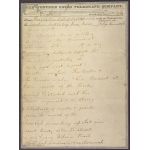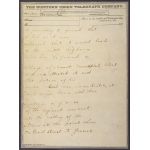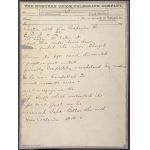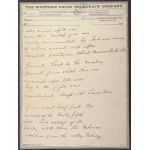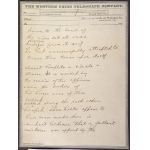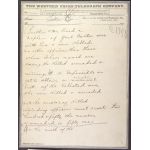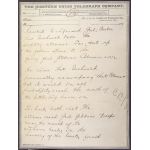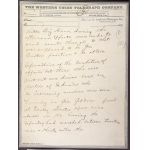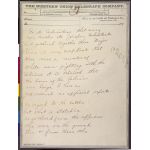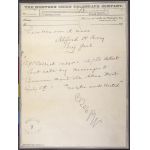First Report of the Battle of the Little Bighorn
6/27/1876
Add to Favorites:
Add all page(s) of this document to activity:
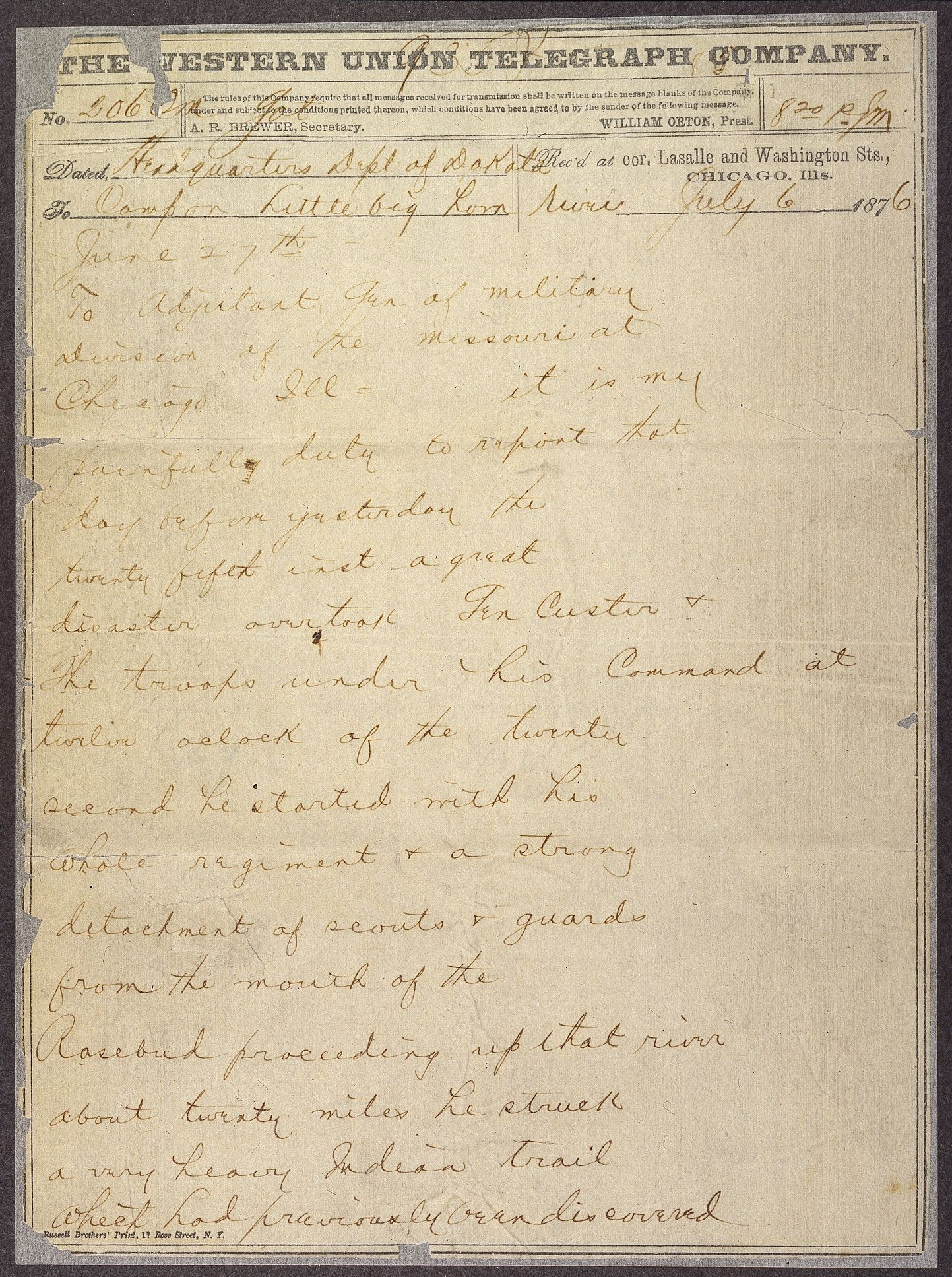
Add only page 1 to activity:
Add only page 2 to activity:
Add only page 3 to activity:
Add only page 4 to activity:
Add only page 5 to activity:
Add only page 6 to activity:
Add only page 7 to activity:
Add only page 8 to activity:
Add only page 9 to activity:
Add only page 10 to activity:
Add only page 11 to activity:
Add only page 12 to activity:
Add only page 13 to activity:
Add only page 14 to activity:
Add only page 15 to activity:
Add only page 16 to activity:
Add only page 17 to activity:
Add only page 18 to activity:
Two days after the battle of Little Bighorn, General Alfred H. Terry, Custer's commanding officer, confirmed the death of Custer and more than 250 of his men. Gathered from the reports of officers who were entrenched in a defensive position on the bluffs overlooking the valley, and from the trail of bodies Terry himself encountered on June 27, he sketched the movements of Custer and his men from June 22 through June 25.
He compiled this report. A civilian scout carried it to Fort Ellis, Montana, the nearest telegraph office, where it was relayed first to Assistant Adjutant General R.C. Drum in Chicago, then to Army headquarters in Washington, DC.
There was a break in the telegraph line between Fort Ellis and Chicago causing a delay in service; and so, the highest officials in the U.S. Army in Philadelphia, attending the grand Centennial Exposition, learned about Custer's fate not from this report, but from a July 6th newspaper story.
He compiled this report. A civilian scout carried it to Fort Ellis, Montana, the nearest telegraph office, where it was relayed first to Assistant Adjutant General R.C. Drum in Chicago, then to Army headquarters in Washington, DC.
There was a break in the telegraph line between Fort Ellis and Chicago causing a delay in service; and so, the highest officials in the U.S. Army in Philadelphia, attending the grand Centennial Exposition, learned about Custer's fate not from this report, but from a July 6th newspaper story.
Transcript
9352THE WESTERN UNION TELEGRAPH COMPANY.
No. 206 [illegible due to tear] Got
The rules of this Company require that all messages received for transmission shall be written on the message blanks of the Company, under and subject to the conditions printed thereon, which conditions have been agreed to by the sender of the following message.
A. R. BREWER, Secretary.
WILLIAM ORTON, Prest.
820 p.m.
Dated, Headquarters Dept of Dakota
To Camp on Little big horn river
Rec'd at cor. Lasalle and Washington Sts.,
CHICAGO, Ills.
July 6 1876
June 27th
To Adjutant Gen of military Division of the Missouri at Chicago Ill=
it is my painfull duty to report that day before yesterday the twenty fifth inst a great disaster overtook Gen Custer & The troops under his Command at twelve oclock of the twenty second he started with his whole regiment & a strong detachment of scouts & guards from the mouth of the Rosebud proceeding up that river about twenty miles he struck a very heavy Indian trail which had previously been discovered
Russell Brothers' Print 17 Ross Street, N.Y.
THE WESTERN UNION TELEGRAPH COMPANY.
No. 206 om
2 [circled]
The rules of this Company require that all messages received for transmission shall be written on the message blanks of the Company, under and subject to the conditions printed thereon, which conditions have been agreed to by the sender of the following message.
A.R. BREWER, Secretary.
WILLIAM ORTON, Prest.
Dated, [blank]
To [blank]
Rec'd at cor. Lsalle and Washington Sts.,
CHICAGO Ills.
[blank] 187
[Note: Preceding text is printed at the top of every page but not filled out. Only those fields filled out will be transcribed on the pages that follow.]
& pursuing it found that it led as it was supposed that it would lead to the Little big horn river here he found a village of almost Enexampled [sic] Extent & at once attacked it with that portion of his force which was immediately at hand major Reno with three Companies a g & m of the regiment was sent into the valley of the stream at the point where the trail struct [sic] it General
Russell Brothers' Print, 17 Ross Street, N.Y. [Note: This text is printed at the bottom of every page. This will not be transcribed on pages that follow.]
3 [circled]
Custer with five Companies C E F I & L [in pencil: attempted] all ample to enter it about three miles lower down [illegible] forded the river Charged Down its left bank dismounted & fought on foot until finally Completely overwhelmed by numbers he he was compelled to mount recross the river & seek a refuge on the high bluffs which overlooked its right bank Just as he recrossed Capt Belton who with three Companies D H &
4 [circled]
K was come two miles to the left of Reno when the action Commenced but who had been ordered by Genl Custer to return came to the river & rightly Concluding that it was useless for his force to attempt to renew the fight in the valley he joined Reno on the bluffs Capt McDougall with his company B was at first at some distance In the rear with a train of pack mules he
5 [circled]
also came up to reno soon this United force was nearly surrounded by Indians many of whom armed with rifles occupied positions which commanded the ground held by the cavalry ground from which there was no escape rifle pits were dug & the fight was maintained though with heavy loss from about half past two oclock of the twenty fifth till Six oclock of the twenty sixth when the Indians withdrew from the valley taking
6
with them their village. Of the movements of Gen Custer & the five Companies under his immediate Command scarcely anything is known from those who witnessed them for no officer or soldier who accompanied him has yet been found alive. His trail from the point where Reno crossed the stream passes along & in the rear of the Crest of the Bluffs on the right bank for nearly or quite three miles then it Comes
7
down to the bank of the river but at once diverges from it as if he had unsuccessfully attempted to cross then turns upon itself almost Completes a circle & closes. It is marked by the remains of this officers & men the bodies of his horses some of them bobbed [inserted in pencil: dropped] along the path others heaped where halts appear to have been made there is abundant Evidence that a gallant resistance was offered by the
8
troops but they were beset on all sides by overpowering numbers. The officers Known to be killed are gen Custer Captains Keogh Gates & Custer Lieuts Cook Smith McIntosh Calhoun porter Hodgeson Sturgis & Reilly of the cavalry Lieut Crittenden of the twentieth infantry & acting asst surgeon Dewolf Lieut Harrington of the Cavalry & asst Surgeon Lord are missing. Capt Benton & Lieut Varnum of the Cavalry are slightly wounded Mr Boston Custer A
9 [circled]
Letter "B"
[in right margin: C 135P]
Brother & Mr Reed a nephew of Genl Custer were with him & were Killed no other officers than those whom I have named are among the Killed wounded & missing. It is Impossible as yet to obtain a nominal [inserted above in pencil: reliable] list of the Enlisted men who were Killed & wounded but the number of killed including officers must reach two hundred & fifty the number of wounded is fifty one
[pencil line across page]
At the mouth of the
10 [circled]
Rosebud I informed Genl Custer that I should take the supply steamer Far-West up the yellow stone to the ferry genl Gibbons Column over the river that I should personally accompany that Column & that it would in all probability reach the mouth of the little big horn on The twenty sixth inst. The steamer reach Genl Gibbons troops near the mouth of the big horn Early in the morning of the twenty fourth
[written in pencil at right margin C1970]
11
[written in pencil at right margin] C140PW]
& at four oclock in the afternoon all his men & animals were across the yellow stone at five oclock The column consisting of five Companies of the seventh Infantry four companies of the second Cavalry & a battery of three gatling guns marched out to & across Tullochs Creek starting soon after five oclock In the morning of the twenty fifth the Infantry made a march of twenty two miles over the most difficult
12
[at right margin C145P]
Country which I have ever seen in order that scouts might be sent into the valley of the Little big horn the Cavalry with the battery was then pushed on thirteen of fourteen miles further reaching camp at midnight the scouts were set out at half past four on the morning of the twenty sixth the scout discovered three Indians who were at first supposed to be sioux but when over taken they proved to
13
[at right margin C 150 PW]
be crows who had been with Gen Custer they brought the first intelligence of the battle their story was not credited it was supposed that some fighting perhaps severe fighting had taken place but it was not believed that disaster Could have overtaken so large a force as twelve Companies of Cavalry, the infantry which had broken camp very Early soon came up & the whole Column Entered & moved up the valley of the
14 [circled]
[at right margin C 154P]
Little Big Horn during the afternoon Efforts were made to send scouts through to what was supposed to be Gen Custers position & to obtain Information of the Condition of affairs but those who were sent out were driven back by parties of Indians who In increasing numbers were seen hovering in Gen Gibbons front at twenty minutes before nine oclock in the Evening the Infantry had marched between twenty nine & thirty miles the
15 [circled]
[at right margin C156 [illegible]]
men were very weary & day light was faling [sic] the Column was therefore halted for the night at a point about Eleven miles in a straight line above the mouth of the stream this morning the movement was resumed & after a march of nine miles Major Renos Entrenchment position was reached the withdrawal of the Indians from around Renos Command & from the valley was undoubtedly caused by the appearance of Gen Gibbons troops
16
[right margin C-2 PW]
Major Reno & Capt Benton both of whom are officers of great Experience accustomed to see large masses of mounted men Estimated the number of Indians engaged at not less than twenty five hundred other officers think that the numbers was greater than this the village in the valley was about three miles in length & about a mile in width besides the lodges proper a great number of temporary brush wood shelter was found
17 [circled]
[at right margin C205P]
In it Indicating that many men besides its proper Inhabitants had gathered together there Major Reno is very confident that there were a number of white men fighting with the Indians it is believed that the loss of the Indians was large I have as yet recieved [sic] no official reports in regard to the battle but what is stated in as gathered from the officers who were on the ground then & from those who
18
have been over it since
Alfred H Terry
Brig Genl
1295 Collect 10365 & 12780 Collect
Govt rate by messenger to Boseman Mont via Helena Mont
July 5th "no extra words counted"
[handwritten C206 PW]
[circular stamp] RECEIVED
JUL
8 ["7" handwritten over the 8]
1876
MIL. [illegible] V. MO.
This primary source comes from the Records of U.S. Army Continental Commands.
National Archives Identifier: 301976
Full Citation: First Report of the Battle of the Little Bighorn, From Gen. Alfred H. Terry, Montana, to Assistant Adjutant General R.C. Drum, Chicago; 6/27/1876; Special Files of Letters Received, 1863 - 1885; Records of U.S. Army Continental Commands, Record Group 392; National Archives Building, Washington, DC. [Online Version, https://www.docsteach.org/documents/document/report-battle-little-bighorn, April 25, 2024]Activities that use this document
- Evaluating Perspectives on Westward Expansion
Created by the National Archives Education Team - The Impact of Westward Expansion on Native American Communities
Created by the National Archives Education Team - The Settlement of the American West
Created by the National Archives Education Team
Rights: Public Domain, Free of Known Copyright Restrictions. Learn more on our privacy and legal page.



